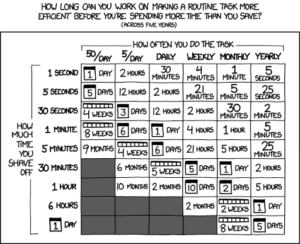We’d all like automated processes to save labor, eliminate errors, reduce the elapsed time from the request to its implementation and save money compared to manual methods, but how can we get a real picture of the savings and improvements? Getting an accurate estimate of labor savings with network automation is key to determining which processes make sense to automate and which to leave as manual. What factors should you consider when evaluating the return on investment of a network automation solution?
Manual Process Time & Frequency
The logical place to start your ROI analysis is with the time consumed by the manual process (i.e., the cost of labor hours), how frequently the process needs to occur, and the labor costs associated with automating the process. However, there are other key factors that should be included to produce an accurate cost-benefit tradeoff.
To start, Randall Munroe, the author of the xkcd.com comic [1], gives us a humorous view of an analysis simply based on the time savings of automating a routine manual task.
Randall’s graphic omits a number of additional factors that your ROI analysis should include:
- Process complexity, which is a controlling factor in the frequency of human error
- The cost of business application downtime when a manual process fails
- The opportunity cost of the staff doing repetitive tasks instead of strategic planning and implementation
- The value of automated processes that improve the business’s ability to compete
Process Complexity and Quality Control
Complex processes may take more time for less experienced staff members to perform, whereas a network expert may be able to skip familiar steps. However, assigning senior staff to changes simply to gain efficiency and/or to improve the quality of the outcome may be prohibitively expensive on its own. Furthermore, as process complexity increases, the potential for human error also increases, irrespective of expertise. Your analysis should include both manual process time as well as estimates of time spent on diagnosing and correcting errors.
Process complexity includes the need to validate that the network is functioning correctly before an automated change and that it is performing as desired after the change. If these checks are not performed, the network team can’t know if a network problem is due to a pre-existing condition (where the pre-deployment state was invalid) or due to a failed deployment (where the post-deployment state is not as intended).
Application Downtime
Some percentage of manual processes will result in a failed change, so you should estimate the cost of application downtime. Creating this estimate can be very difficult without a lot of historical data and analysis. Your change control and trouble ticketing systems are a good source of this data and the operations team should be able to provide the necessary information.
Supporting Tasks
Make sure that your ROI analysis includes automation’s impact on all the supporting steps, not just implementation. The task timeline for automation we did for a customer showed that supporting steps consumed 38% of the total time, some of which was reduced during automation.
Figure 1: Task Timeline Before Automation
Automating the task eliminated the initial review and the implementation steps while also shortening the request and follow-up phase, resulting in a reduction for this task from 124 minutes to 26 minutes – a 79% reduction in the overall manual process time.
Opportunity Costs & Competitiveness
Don’t forget to estimate the cost of having the team performing manual processes instead of planning for or implementing network changes that support new business objectives.
What is the cost of delayed implementation because the team is busy with manual processes? Automation of simple actions through a self-service portal could allow the team to work on things that increase business agility in a competitive marketplace. The example in Figure 1 was for renewals of web site certificates, which impacted customer interaction with the organization.
To get an accurate view of the ROI of an automation solution, you should consider a variety of factors. While the savings in labor costs are important, don’t overlook the other factors that should be included in the calculation.
[1] https://xkcd.com/1205/ and a related comic: https://xkcd.com/1319/


